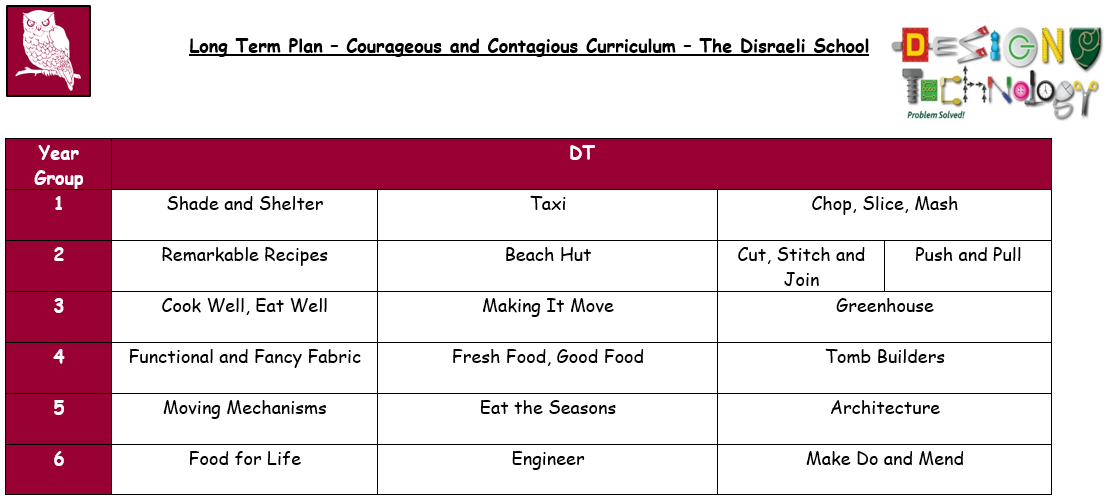DT

Intent
At The Disraeli School, through the Design and Technology curriculum, children will take risks, solve problems and combine creativity and technical expertise in order to design, make and evaluate products linked to their learning across the curriculum, becoming proud innovators in their own right. We intend for all children to acquire appropriate subject knowledge, skills and understanding as set out in the National Curriculum, built up sequentially through carefully designed units of learning. Disraeli pupils will learn to produce items which match not only their own values and needs, but also connect strongly to the topics which they learn about in our Contagious and Courageous Curriculum. Wherever possible, links between other curriculum areas (such as science and mathematics) will be made so that children have an awareness of their multidisciplinary skills.
Implementation
We have a clear and comprehensive scheme of work in line with the National Curriculum and the school aims. Children have access to key knowledge, vocabulary and meanings to understand Design and Technology and to use these skills across the curriculum. In Design and Technology children are asked to solve problems and develop their learning independently. This allows the children to have more ownership over their curriculum and lead their own learning in Design and Technology. When designing and making, the children are taught to:
Design:
• use research and develop design criteria to inform the design of innovative, functional, appealing products that are fit for purpose, aimed at particular individuals or groups.
• generate, develop, model and communicate their ideas through discussion, annotated sketches, cross-sectional diagrams, prototypes, pattern pieces and computer-aided design.
Make:
• select from and use a wider range of tools and equipment to perform practical tasks (for example, cutting, shaping, joining and finishing, as well as chopping and slicing) accurately.
• select from and use a wider range of materials, ingredients and components, including construction materials, textiles and ingredients, according to their functional properties, aesthetic qualities and, where appropriate, taste.
Evaluate:
• investigate and analyse a range of existing products.
• evaluate their ideas and products against their own design criteria and consider the views of others to improve their work.
• understand how key events and individuals in design and technology have helped shape the world.
Technical knowledge:
• apply their understanding of how to strengthen, stiffen and reinforce more complex structures. • understand and use mechanical systems in their products.
• understand and use electrical systems in their products.
• apply their understanding of computing to program, monitor and control their products
• Understand some of the ways that food can be processed and the effect of different cooking practices (including baking and grilling).
Key skills and key knowledge for Design and Technology have been mapped across the school to ensure progression between year groups, with learning revisited and then built up sequentially over time. The context for the children’s work in Design and Technology is also well considered and children learn about real life structures and the purpose of specific examples, as well as developing their skills throughout the programme of study.
Impact
Because of the high-quality design and technology education children will have developed their cultural capital and can create solutions to relevant problems. Through carefully planned and implemented learning activities the pupils will possess the creative, technical and practical expertise needed to perform everyday tasks confidently and to participate successfully in an increasingly technological world. They will be better prepared for applying their critical thinking skills to real-world situations as they continue their learning journey throughout Disraeli, into secondary school and then the wider world.
Curriculum subject links
Curriculum-Gallery (ID 1060)
-
EnglishReading and Writing
-
PhonicsLearning to read
-
MathematicsMaths across the school
-
HistoryLearning about the past
-
GeographyAll around the world
-
ScienceHow things work
-
PEPhysical Education
-
RSERelationships and Sex Education
-
PSHEPersonal, Social, Health Education
-
ComputingInformation and Digital Technology
-
MusicPlaying, Appreciation and Notation
-
REReligious Education
-
Modern Foreign LanguageFrench
Modern Foreign Language
-
ArtArt and Design
-
Design and TechnologyDesign, Make, Evaluate and Technical Knowledge
Design and Technology


